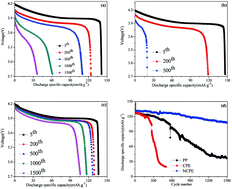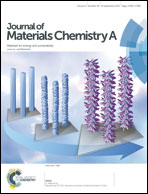Nanocomposite polymer membrane derived from nano TiO2-PMMA and glass fiber nonwoven: high thermal endurance and cycle stability in lithium ion battery applications
Abstract
With the aim to overcome the high thermal shrinkage of conventional polyolefin separators and improve the electrochemical properties of lithium ion batteries, a nano-composite polymer electrolyte membrane (NCPE) is attempted by introducing highly dispersed nano-TiO2 hybrid doped poly(vinylidene fluoride–hexafluoro propylene) (PVDF–HFP) into a glass fiber nonwoven, which is easily available at low costs. The physical and electrochemical properties of the obtained NCPE are characterized using SEM, thermal shrinkage tests, AC impedance measurements, and charge–discharge and cycling tests. The results show that the NCPE possesses higher porosity and higher thermal dimensional stability temperature than a conventional PP separator. In addition, the electrochemical properties, such as liquid uptake, ionic conductivity and interface compatibility, of the polymer electrolyte membrane and the metallic Li electrode was improved significantly. In particular, the LiCoO2/Li coin cell with NCPE exhibits good C-rate performances of up to 85% at 10C-rate of the capacity at 1C-rate, and capacity retention ratios up to 80% after 1500 cycles at 1C/2C charge–discharge cycling. This study shows that the glass fiber nonwoven, which is easily available at low cost, can be a high performance separator for Li-ion battery applications.



 Please wait while we load your content...
Please wait while we load your content...